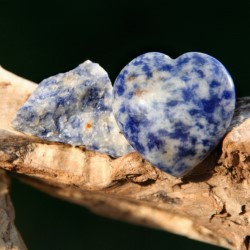This blue and white speckled stone, which is very popular as a gemrock, has been mined in Brazil since 1965. The name "Azul Bahia", which is commonly used in the stonemasonry industry, refers to this origin.
Petrologically, it is a syenite rock with approx. 50% microclinic feldspar, 30% sodalite, 10% cancrinite, 5% plagioclase as well as 5% aegirine and other dark components. Syenites are magmatic alkaline rocks with a very low content of quartz, but often enriched with exotic minerals. Their main mineral composition usually comprises alkali feldspars, amphibole- and/or pyroxenes-minerals or plagioclase feldspars and biotite. In addition, rare minerals such as astrophyllite, eudialyte or (as in in the case of sodalite syenite) sodalite occur in larger quantities.
The mineral Sodalite is closely related to an other blue mineral: lasurite, one of the coloring minerals of Lapis Lazuli rock. Contact with (even weak) acids should be avoited, as it can turn grey under their influence.
Sodalite-syenite is widely used as a decorative stone (gemrock) in the jewellery industry, where it is often simplified called "Sodalite".




